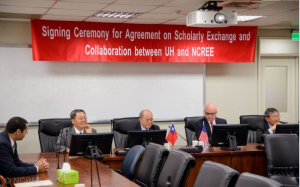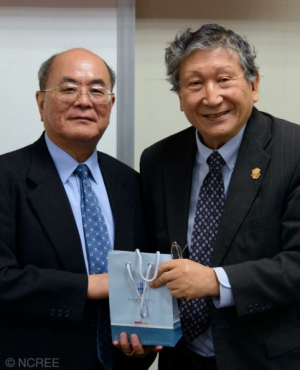Continuing a successful 15-year-long partnership, the UH Cullen College’s Department of Civil and Environmental Engineering (CEE) has renewed its collaborative agreement with the National Center for Research on Earthquake Engineering (NCREE) in Taipei, Taiwan for another five years.
Recognized as one of the best earthquake research centers in the world, NCREE is home to two of the largest tri-axial shake tables, used to simulate the response of structures to earthquakes. Shake table experiments provide data that is crucial for assessing the seismic performance of infrastructure components and for improving design procedures.
“What do they bring to the table? They bring the table!” said Roberto Ballarini, Thomas and Laura Hsu Professor and Department Chair of Civil and Environmental Engineering.
But that’s not all they boast.
“Unlike in the United States, where the experimental structures are most often built and tested by graduate students, NCREE employs professional engineers and technicians to do the work,” said Ballarini.
The synergistic relationship between CEE and NCREE is the result of the efforts of Thomas Hsu, Moores Professor of CEE and Yi-Lung Mo, who helped found NCREE in 1991, and joined UH as professor of civil and environmental engineering in 2000. Both are internationally recognized experts in structural engineering. In fact Hsu’s past research formed the basis for the shear and torsion design provisions in the American Concrete Institute Building Code.
Mo and Hsu travel to Taiwan two-to-three times a year to collaborate with the center’s researchers and graduate students. The many fruits of the collaboration include the UH-developed analytical models for predicting the mechanical behavior of infrastructure elements that have been implemented in the finite element analysis program, Simulation of Concrete Structures (SCS). The models were verified by a series of large scale tests conducted at NCREE. Currently SCS can be used to perform seismic design and evaluation of engineering structures such as high-rise buildings, cable-stayed bridges, off-shore platforms, and nuclear containments.
The expertise brought to NCREE by UH faculty enables NCREE to fulfill its mission to improve the reliability and reduce the cost of concrete structures, building materials and designs of structures subjected to earthquakes. Mo’s seen the process work, pointing to the 1999 Jiji earthquake in Taiwan, which took more than 2,400 lives and destroyed 51,711 buildings. Following that catastrophe, Mo led a team of 20 researchers and engineers in redesigning Taiwan’s seismic design code.
Flash forward to 2016 when a similar earthquake hit the area and the buildings that adhered to the recommended retrofits in the improved code book, stood stock still, undamaged.
The partnership between the Cullen College and NCREE benefits UH students, who also travel to Taipei to work with professionals at the center.
Together, Ballarini says, UH and the center develop high quality research and design safer structures.
That’s a partnership built to last.


